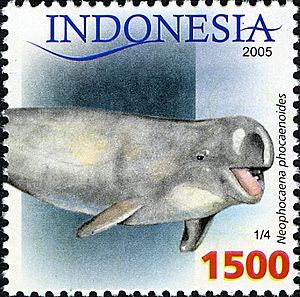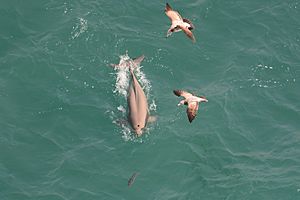Finless porpoise facts for kids
The Finless Porpoise is a fascinating sea animal, a type of marine mammal. It is closely related to dolphins and whales. These porpoises live in shallow waters along the coast of Asia. You can find them from the Persian Gulf all the way to Japan. They also live in some big rivers like the Yangtze, Gan, and Xiang rivers. A special thing about them is that they don't have a dorsal fin (the fin on their back) like most other dolphins.
Contents
Where Finless Porpoises Live
Finless porpoises live in the coastal waters of Asia. This includes countries like Japan, Korea, China, Indonesia, Malaysia, India, and Bangladesh. They usually stay in shallow areas, often less than 50 meters (164 feet) deep. These areas are usually close to the shore. They prefer waters with soft or sandy seabeds. You might also find them in estuaries (where rivers meet the sea) and mangrove swamps. Sometimes, they are seen further out, about 135 kilometers (84 miles) offshore. This happens in places like the East China and Yellow Seas, but even there, they stay in shallow parts.
What Finless Porpoises Look Like
The Finless Porpoise is unique because it doesn't have a tall dorsal fin on its back. Instead, it has a low ridge of thick skin. This ridge has tiny bumps called tubercles. Their forehead is also quite steep compared to other porpoises. They have fewer teeth than other porpoises, usually between fifteen and twenty-one teeth in each jaw.
Finless porpoises can grow up to 2.27 meters (7.4 feet) long. They can weigh as much as 72 kilograms (159 pounds). However, most are a bit smaller. Their flippers are fairly large, reaching up to 20% of their total body length. Adult porpoises are usually a light grey color all over. Some might have lighter skin around their mouth or darker patches near their flippers.
When they are born, calves (baby porpoises) in central and eastern areas are mostly black. They have some grey around their dorsal ridge. They turn fully grey after about four to six months. But calves in western areas are born a light creamy grey. They become darker as they get older.
Adults usually grow to be more than 1.55 meters (5 feet) long. They weigh between 30 and 45 kilograms (65 to 100 pounds).
Inside a Finless Porpoise
Scientists have studied the inside of finless porpoises quite a lot. For example, the tiny bumps (tubercles) on their back ridge have many nerve endings. These might help them sense things around them. Their hearing is also very good. They have large nerve fibers that help their ears and brain communicate quickly. However, their eyesight is not as strong. They have a smaller lens in their eye and fewer nerves for vision.
Their skeleton is surprisingly light. It makes up only about 5% of their total body weight. They have between 58 and 65 bones in their spine. About half of these are in their tail. The first three bones in their neck are joined together. They also have ten to fourteen pairs of ribs in their chest.
The nasal passage (where they breathe) has many air sacs. These sacs have a complex structure. They can seal off all the air inside the passage. Their stomach has three different parts.
What Finless Porpoises Eat
Finless porpoises are not picky eaters. They eat many different types of food found in their habitat. This includes fish, crustaceans (like crabs and shrimp), and cephalopods (like squid and octopuses). People have seen them eating fish, shrimp, and squid in the Yellow Sea and off Pakistan. In Japanese waters, they eat fish, shrimp, squid, cuttlefish, and octopuses.
When they live in estuaries, mangroves, and rivers, they also seem to eat some plant material. This can include leaves, rice, and even eggs laid on plants.
Finless Porpoise Behavior
In Chinese coastal waters and the Yangtze River, finless porpoises usually live in groups of three to six. Sometimes, larger groups of up to fifty porpoises have been seen. In Japanese waters, groups are smaller, often just two porpoises. Even the rare larger groups there are usually no more than thirteen individuals.
Scientists think that a mother and her calf (baby) are the main family unit. Groups of three or more are often just these family units or single porpoises coming together. Their social structure is not very complex. The mother and calf pair is likely the only stable social group.
Like other porpoises, they are not as active or showy as dolphins. They don't usually ride the waves made by boats. In some areas, they seem to be shy of boats. However, in the Yangtze River, finless porpoises have been seen leaping out of the water. They also do "tail stands," where they balance upright on their tails.
Finless porpoises make two main types of sounds. They make high-frequency clicking sounds. They also make longer, low-frequency tones. The clicks are used for echolocation, which helps them find food and navigate. The longer tones might be for communicating with each other.
A recent study from the Woods Hole Oceanographic Institution showed that dolphins have different hearing abilities. This means that we can't assume all cetaceans (whales, dolphins, and porpoises) hear the same way.
Reproduction and Life Cycle
Finless porpoises usually breed in late spring and early summer. The young are born in spring, summer, or winter, depending on where they live. The mother carries the baby for ten to eleven months before it is born. Newborn finless porpoises are about 72 to 84 centimeters (28 to 33 inches) long.
Male porpoises are ready to have babies when they are four to six years old. Females are ready when they are six to nine years old. Finless porpoises can live for up to 33 years.
It has been suggested that young calves might cling to the bumpy skin on their mother's back. This would allow the mother to carry them as she swims. However, there isn't clear proof that this happens. Calves drink milk from their mothers for about 6 to 15 months.




